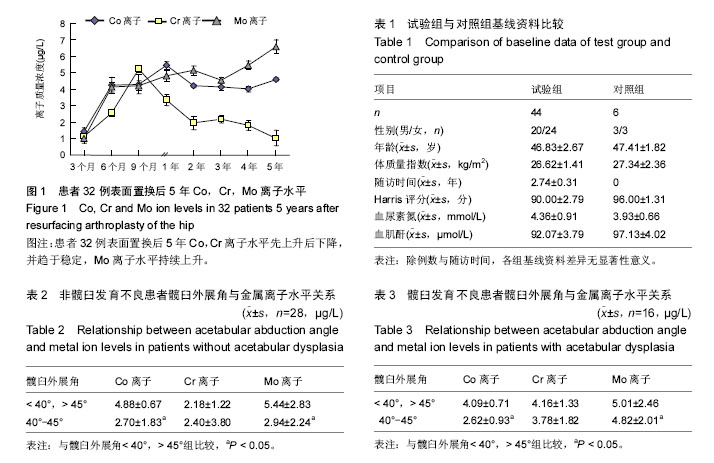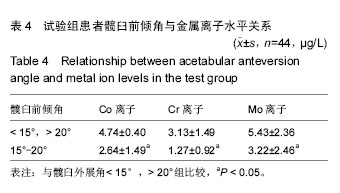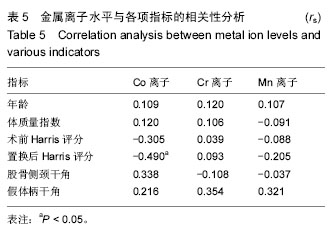| [1] 姜文学,尤佳,李轶津,等.髋关节表面置换的近期疗效及其并发症分析[J].中华骨科杂志,2009,29(9):858-863.[2] 王晓永,张卫国,吕德成,等.金属对金属全髋关节置换与全膝关节置换后早期钴铬钼离子的释出[J].中华骨科杂志, 2009,29(10):920-923.[3] Back DL, Young DA, Shimmin AJ. How do serum cobalt and chromium levels change after metal-on-metal hip resurfacing? Clin Orthop Relat Res. 2005;438:177-181.[4] Kim PR, Beaulé PE, Dunbar M, et al. Cobalt and chromium levels in blood and urine following hip resurfacing arthroplasty with the Conserve Plus implant. J Bone Joint Surg Am. 2011;93(2):107-117.[5] Daniel J, Ziaee H, Pradhan C, et al. Blood and urine metal ion levels in young and active patients after Birmingham hip resurfacing arthroplasty: four-year results of a prospective longitudinal study. J Bone Joint Surg Br. 2007;89(2):169-173.[6] Silverman Edward J, Blair A, Sheth Neil P. Metal-on-metal total hip arthroplasty: is there still a role in 2016? 2016;9(1):93-96.[7] Moroni A, Savarino L, Hoque M, et al. Do ion levels in hip resurfacing differ from metal-on-metal THA at midterm? Clin Orthop Relat Res. 2011;469(1): 180-187.[8] Visuri T, Borg H, Pulkkinen P, et al. A retrospective comparative study of mortality and causes of death among patients with metal on metal and metal on polyethylene total hip prostheses in primary osteoarthritis after a long term follow up. BMC Musculoskelet Disord. 2010;11:78.[9] Khan M, Takahashi T, Kuiper JH, et al. Current in vivo wear of metal-on-metal bearings assessed by exercise-related rise in plasma cobalt level. J Orthop Res. 2006;24(11):2029-2035.[10] Heisel C, Silva M, Skipor AK, et al. The relationship between activity and ions in patients with metal-on-metal bearing hip prostheses. J Bone Joint Surg Am. 2005;87(4):781-787.[11] Shahrdar C, Campbell P, Mirra J, et al. Painful metal-on-metal total hip arthroplasty. J Arthroplasty. 2006;21(2):289-293.[12] Reito A, Puolakka T, Elo P, et al. Outcome of Birmingham hip resurfacing at ten years: role of routine whole blood metal ion measurements in screening for pseudotumours. Int Orthop, 2014;38(11):2251-2257.[13] Khan M, Takahashi T, Kuiper JH, et al. Current in vivo wear of metal-on-metal bearings assessed by exercise-related rise in plasma cobalt level. J Orthop Res. 2006;24(11):2029-2035.[14] Matteo C, Giuseppe T, Andrea S, et al. Hip Resurfacing Implants. Orthopedics. 2015;38(8): 504-509.[15] 唐智,桂斌捷,丁楠,等.全髋关节置换后不同体位摄片髋臼角度的变化[J].中国组织工程研究,2016,20(26): 3817- 3822.[16] Mellon Stephen J, George G, Andersen Michael S, et al. Optimal acetabular component orientation estimated using edge-loading and impingement risk in patients with metal-on-metal hip resurfacing arthroplasty. J Biomech. 2015;48(2):318-323.[17] 邵建树,厉晓龙,刘伟峰,等.全髋关节置换中臼杯放置角度对关节屈伸活动安全性的影响[J].中国组织工程研究, 2015, 19(44):7053-7058.[18] Hart AJ, Skinner JA, Henckel J, et al. Insufficient acetabular version increases blood metal ion levels after metal-on-metal hip resurfacing. Clin Orthop Relat Res. 2011;469(9):2590-2597.[19] Langton DJ, Joyce TJ, Mangat N, et al. Reducing metal ion release following hip resurfacing arthroplasty. Orthop Clin North Am. 2011;42(2):169-180.[20] Langton DJ, Sprowson AP, Joyce TJ, et al. Blood metal ion concentrations after hip resurfacing arthroplasty: a comparative study of articular surface replacement and Birmingham Hip Resurfacing arthroplasties. J Bone Joint Surg Br. 2009;91(10):1287-1295.[21] Robinson PG, Wilkinson AJ, Meek RM. Metal ion levels and revision rates in metal-on-metal hip resurfacing arthroplasty: a comparative study. Hip Int. 2014;24(2): 123-128.[22] Holland JP, Langton DJ, Hashmi M. Ten-year clinical, radiological and metal ion analysis of the Birmingham Hip Resurfacing. J Bone Joint Surg Br. 2012;94(4): 471-476.[23] Harlan C,Amstutz MD,Karren M. The effect of patient selection and surgical technique on the results of Conserve® Plus hip resurfacing--3.5-to-14-year follow-up. Orthop Clin N Am. 2011;42(2):133-142. [24] De Steiger RN, Hang JR, Miller LN, et al. Five-year results of the ASR XL acetabular system and the ASR hip resurfacing system an analysis from the australian orthopaedic association national joint replacement registry. J Bone Joint Surg Am. 2011;93(24):2287- 2293.[25] Reito A, Puolakka T, Elo P, er al. High prevalence of adverse reactions to metal debris in small-headed ASR™ hips. Clin Orthop Relat Res. 2013;471(9):2954- 2961.[26] Jarvis IW, Meczes EL, Thomas HD, et al. Therapy-induced carboplatin-DNA adduct levels in human ovarian tumours in relation to assessment of adduct measurement in mouse tissues. Biochem Pharmacol. 2012,83(1):69-77.[27] Rezi? I, Curkovi? L, Ujevi? M. Simple methods for characterization of metals in historical textile threads. Talanta. 2010;82(1):237-244.[28] Matthies A, Underwood R, Cann P, et al. Retrieval analysis of 240 metal-on-metal hip components, comparing modular total hip replacement with hip resurfacing. J Bone Joint Surg Br. 2011;93(3):307-314.[29] Langton DJ, Jameson SS, Joyce TJ, et al. Early failure of metal-on-metal bearings in hip resurfacing and large-diameter total hip replacement: a consequence of excess wear. J Bone Joint Surg Br. 2010;92(1): 38-46.[30] Daniel J, Ziaee H, Pradhan C, et al. Six-year results of a prospective study of metal ion levels in young patients with metal-on-metal hip resurfacings. J Bone Joint Surg Br. 2009;91(2):176-179.[31] Bitsch RG, Zamorano M, Loidolt T, et al. Ion production and excretion in a patient with a metal-on-metal bearing hip prosthesis. A case report.J Bone Joint Surg Am. 2007;89(12):2758-2763.[32] Macpherson GJ, Breusch SJ. Metal-on-metal hip resurfacing: a critical review. Arch Orthop Trauma Surg. 2011;131(1):101-110.[33] Hosman AH, van der Mei HC, Bulstra SK, et al. Effects of metal-on-metal wear on the host immune system and infection in hip arthroplasty. Acta Orthop. 2010; 81(5): 526-534. |
.jpg)



.jpg)